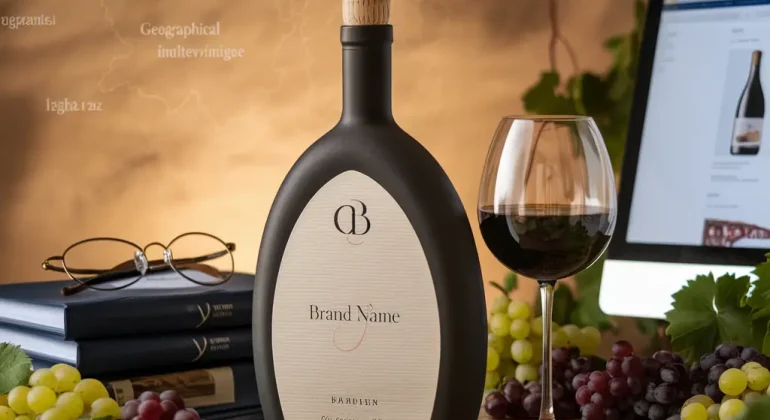The wine industry represents a unique confluence of tradition, innovation, and commerce. Intellectual property (IP) law plays a pivotal role in preserving this delicate balance by safeguarding trademark identities, regional heritage, and innovative practices. This article delves into the intricacies of IP law in the wine sector, examining the role of trademarks, geographical indications, and other IP tools in protecting the interests of stakeholders while fostering innovation.
Sommaire
The pillars of intellectual property in the wine industry
I – Trademarks: Securing brand identity
Trademarks are vital for distinguishing one producer’s products from another. In a competitive market, a strong trademark ensures brand recognition, consumer loyalty, and legal protection against imitation.
There are challenges in trademark registration :
- Similarity of Products: Many wine trademarks fall under Class 33 (alcoholic beverages excluding beers). The dense registration landscape often leads to disputes regarding the similarity of products and signs.
- Example: Opposition cases where trademarks like “MARQUIS DELATRE” and “MARQUÈS DEL ATRIO” were scrutinized for phonetic and visual resemblance.
- Distinctiveness: Terms such as “Château” or “Domaine”, often used descriptively, require additional elements for registration.
Recent rulings from bodies like the French INPI and the EUIPO emphasize the need for trademarks to exhibit clear distinctiveness and avoid consumer confusion. For instance, rulings on marks like “LOUIS DE LA ROCHE” and “DOMAINE DE LA ROCHE” underline the importance of evaluating the overall impression of signs.
II- Geographical Indications: Preserving regional heritage
Geographical indications protect the names of regions associated with specific qualities or reputations, ensuring authenticity and preserving cultural heritage. Examples include Champagne, Bordeaux, and Chianti.
The EU’s comprehensive framework, such as the recent Regulation (EU) No. 2024/1143, governs the use and protection of GIs.
Some case studies :
- Evocation and Misuse: Attempts to register terms evocative of protected geographical indication, such as “TIZZANO” for Corsican wines, often lead to legal challenges. Courts examine whether such terms might mislead consumers.
- Modification of Specifications: Changes to PDO (Protected Designation of Origin) rules, such as permitting new grape varieties, must align with preserving the essence of the GI.
III – Innovation and patents in viticulture
Innovations in vineyard management and winemaking—from advanced irrigation systems to fermentation techniques—can be patented. Such protection incentivizes R&D while allowing producers to capitalize on their ingenuity.
While patents foster innovation, the wine sector’s reliance on tradition necessitates careful consideration of cultural impacts. For example, patents related to non-traditional production methods, like de-alcoholized wines, must respect established GI rules.
IV – Design Protection: Packaging and presentation
The aesthetic appeal of wine packaging often influences consumer choice. Design rights protect elements like bottle shapes, labels, and closures, ensuring that unique presentations remain exclusive to their creators.
Innovative designs, such as eco-friendly packaging, have gained traction. Protecting these designs reinforces a producer’s commitment to sustainability and brand differentiation.
Enforcement and Dispute Resolution
Infringement Challenges
The wine industry’s premium products are frequent targets of counterfeiting. IP enforcement mechanisms, such as customs interventions and litigation, are essential for combating this issue.
Domain Name Disputes
Cybersquatting cases, such as those involving domain names mimicking famous wine brands, highlight the need for vigilance in digital spaces. The UDRP (Uniform Domain-Name Dispute-Resolution Policy) provides an effective resolution mechanism.
Arbitration and Mediation
Given the international nature of the wine trade, alternative dispute resolution methods like WIPO arbitration offer efficient solutions to cross-border IP conflicts.
Sustainability and IP
As sustainability becomes a market priority, producers are leveraging IP to protect eco-friendly innovations and branding strategies.
Digital Marketing and E-commerce
With the rise of e-commerce, protecting trademarks and designs in digital marketplaces is increasingly critical.
Strengthening International Cooperation
Harmonizing IP standards through international agreements, such as the Lisbon Agreement and TRIPS, is essential for ensuring robust protection across jurisdictions.
Conclusion
The wine industry’s reliance on intellectual property law underscores its commitment to preserving heritage while embracing innovation. By navigating the complexities of trademarks, geographical indications, patents, and design rights, stakeholders can protect their assets and ensure a thriving future for viticulture worldwide. Effective enforcement and adaptation to emerging trends will further solidify the role of IP as a cornerstone of the wine sector’s success.
Dreyfus Law Firm excels in protecting and promoting wine trademarks, as well as managing appellations of origin (AOC/AOP) and geographical indications (GI). With our deep expertise in intellectual property and wine law, we support producers, trade unions, and other stakeholders in safeguarding and enhancing their products.
Join us on social media !

